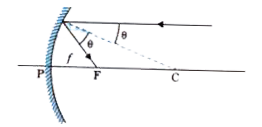A ray parallel to principal axis is incident at 30∘ from normal on concave mirror having radius of curvature R. The point on principal axis where rays are focussed is Q such that PQ

R2
R√3
2√R−R√2
R(1−1√3)
The correct Answer is:D
From similar triangles,
QCsin30∘=Rsin120∘
orQC=R×sin30∘sin120∘

=R√3
Thus PQ=PC−QC=R−R√3=R(1−1√3)
Topper's Solved these Questions
- RAY OPTICS AND OPTICAL INSTRUMENTSBook:DISHA PUBLICATIONChapter:RAY OPTICS AND OPTICAL INSTRUMENTSExercise:Exercise - 1 : Concept Builder (Topicwise)(Topic 2 : Refraction of Light at Plane Surface and Total Internal Reflection)
Explore 17 Videos
- RAY OPTICS AND OPTICAL INSTRUMENTSBook:DISHA PUBLICATIONChapter:RAY OPTICS AND OPTICAL INSTRUMENTSExercise:Exercise - 1 : Concept Builder (Topicwise)(Topic 3 : Refraction of light at Spherical Surface and Power of Lens)
Explore 15 Videos
- RAY OPTICS AND OPTICAL INSTRUMENTSBook:DISHA PUBLICATIONChapter:RAY OPTICS AND OPTICAL INSTRUMENTSExercise:Exercise -2 : Concept Applicator
Explore 26 Videos
- PHYSICAL WORLD, UNITS AND MEASUREMENTSBook:DISHA PUBLICATIONChapter:PHYSICAL WORLD, UNITS AND MEASUREMENTSExercise:Exercise - 2 : Concept Applicator
Explore 30 Videos
- SEMICONDUCTOR ELECTRONICS : METERIALS, DEVICES AND SIMPLE CIRCUITSBook:DISHA PUBLICATIONChapter:SEMICONDUCTOR ELECTRONICS : METERIALS, DEVICES AND SIMPLE CIRCUITSExercise:EXERCISE -2: CONCEPT APPLICATOR
Explore 25 Videos
Similar Questions
A ray of light parallel to principal axis after reflection from concave mirror passes through……….. .
View SolutionA point object on the principal axis at a distance 1.5 cm in front of concave mirror of radius of curvature 20 cm has velocity 2mm/s is perpendicular to the principal axis. The velocity of image at that instant will be
View Solution
Knowledge Check
A ray parallel to the principal axis after reflection from a concave mirror will pass through
Aprincipal focusBprincipal axisCradius of curvatureDcentre of curvatureA point object on the principal axis at a distance 1.5 cm in front of concave mirror of radius of curvature 20 cm has velocity 2mm/s is perpendicular to the principal axis. The velocity of image at that instant will be
A2mm/sB4 mm/sC8 mm/sD16 mm/s
Rays parallel to principal axis, incident on the spherical mirror at different heights from principal axis are focused at different points. And due to this reason we cannot define unique focus. This is known as spherical aberration. Angle of incidence θ shown in figure depends on the height of ray above principal axis. Focal length of spherical mirror can be easily written in terms of angle θ shown in figure as follows :
f=R−R2secθ
Here R is radius of curvature of mirror. The light rays which are very close to principal axis are known as paraxial rays and rays far away from principal axis are called marginal rays.
What will be the focal length for ray which is incident at an angle 60∘?AWhat will be the focal length for ray which is incident at an angle 60∘ ?BRC2RDR/2
A point object on the principal axis at a distance 1.5cm in front of a concave mirror of radius of curvature 20cm has velocity ,2mm/s perpendicular to , the principal axis.The velocity of image at that instant will be
View Solution
Rays parallel to principal axis, incident on the spherical mirror at different heights from principal axis are focused at different points. And due to this reason we cannot define unique focus. This is known as spherical aberration. Angle of incidence θ shown in figure depends on the height of ray above principal axis. Focal length of spherical mirror can be easily written in terms of angle θ shown in figure as follows :
f=R−R2secθ
Here R is radius of curvature of mirror. The light rays which are very close to principal axis are known as paraxial rays and rays far away from principal axis are called marginal rays.
Let fP and fm represent the focal length corresponding to paraxial rays and marginal rays respectively then
View Solution
Rays parallel to principal axis, incident on the spherical mirror at different heights from principal axis are focused at different points. And due to this reason we cannot define unique focus. This is known as spherical aberration. Angle of incidence θ shown in figure depends on the height of ray above principal axis. Focal length of spherical mirror can be easily written in terms of angle θ shown in figure as follows :
f=R−R2secθ
Here R is radius of curvature of mirror. The light rays which are very close to principal axis are known as paraxial rays and rays far away from principal axis are called marginal rays.
For paraxial rays focal length is approximately
View SolutionA point object on the principal axis at a distance 15cm in front of a concave mirror of radius of curvature 20cm has velocity 2mm/s perpendicular to the principal axis. The magnitude of velocuty of image at that instant will be
View SolutionA ray of light is incident on a concave mirror. If it is parallel to the principal axis, the reflected ray will
View Solution

